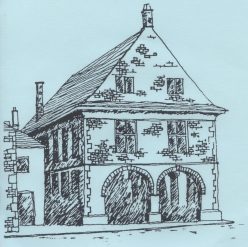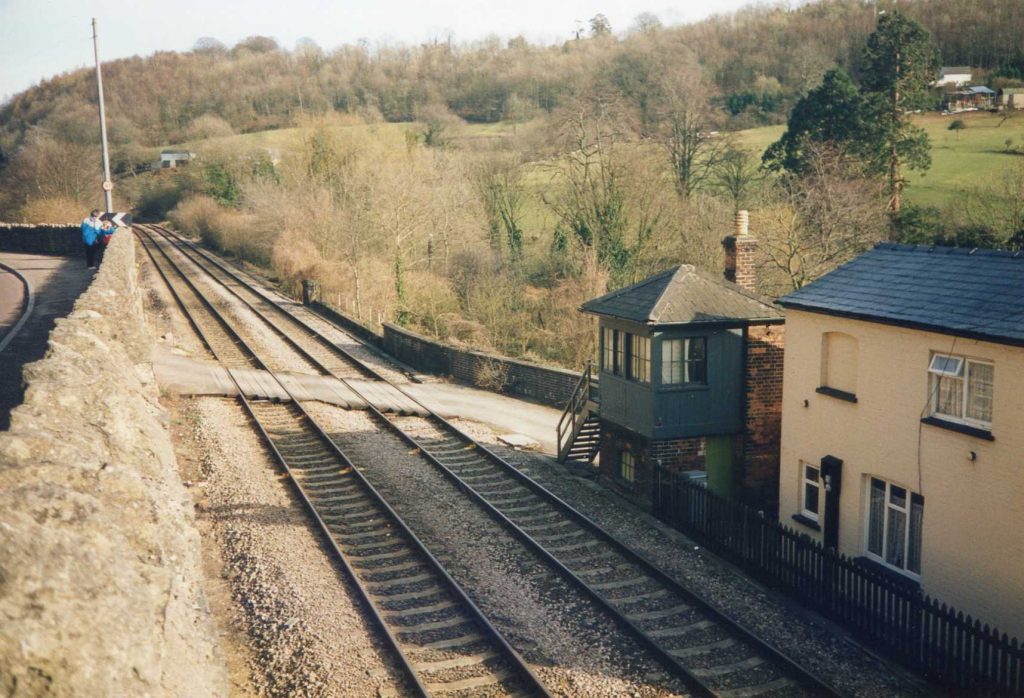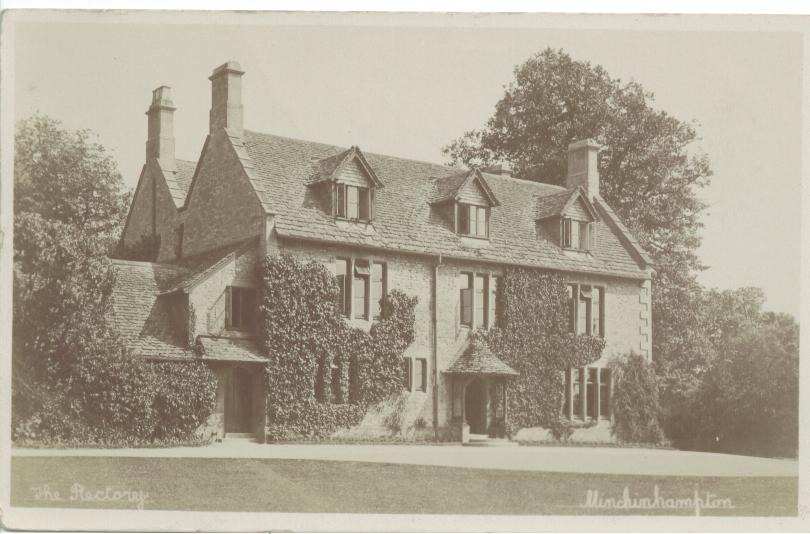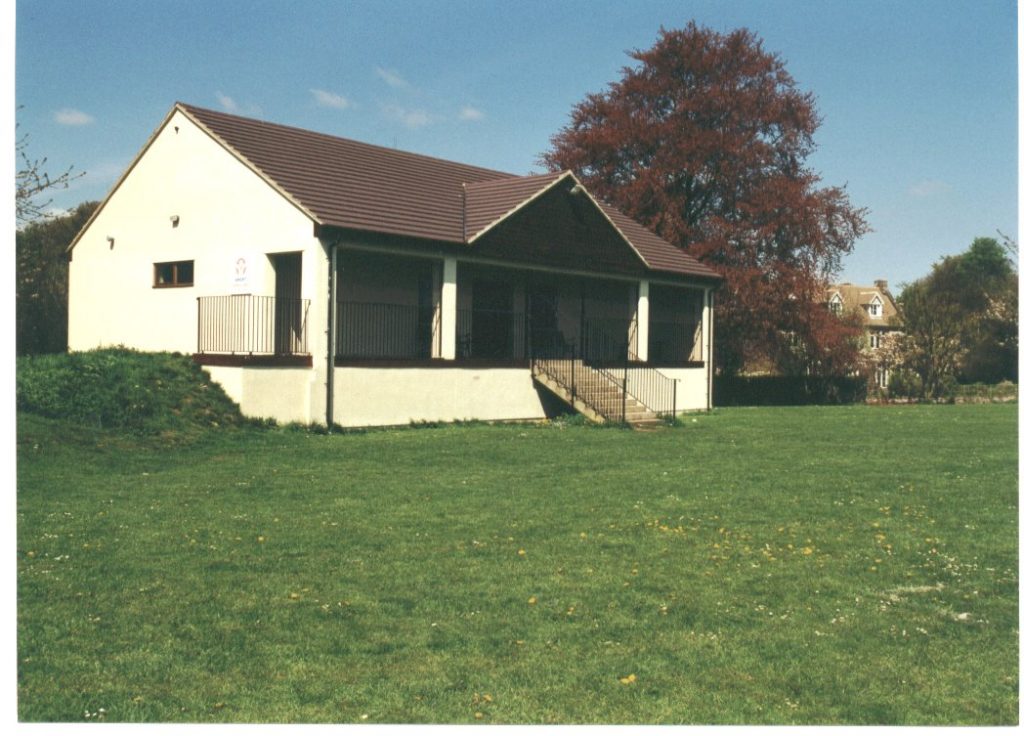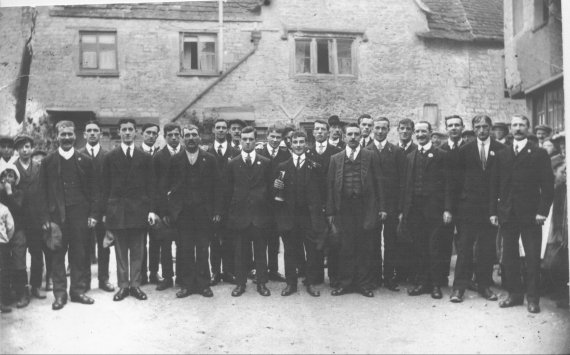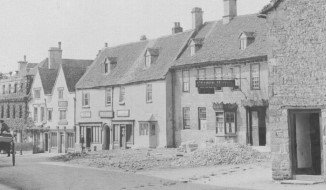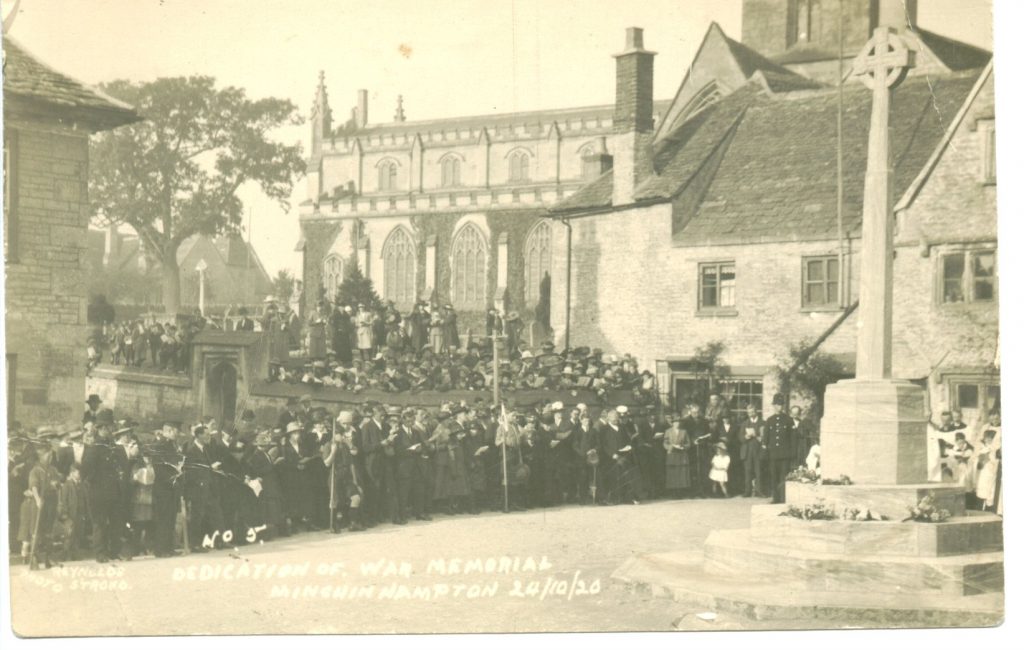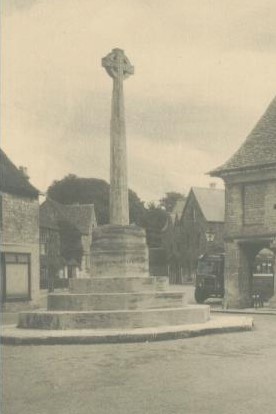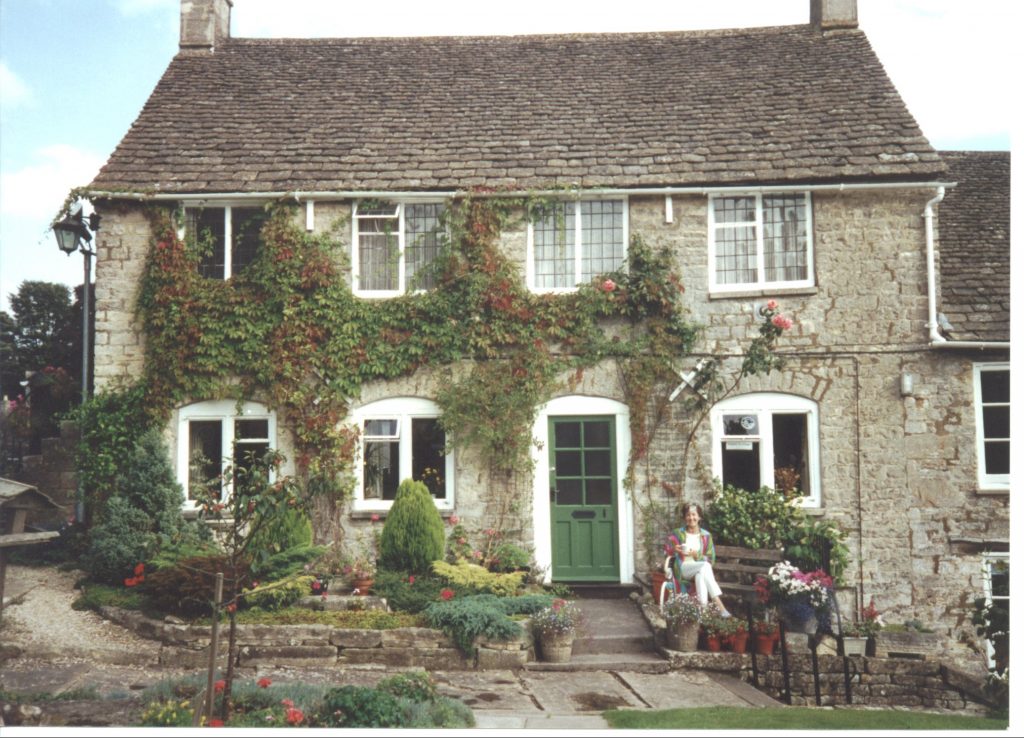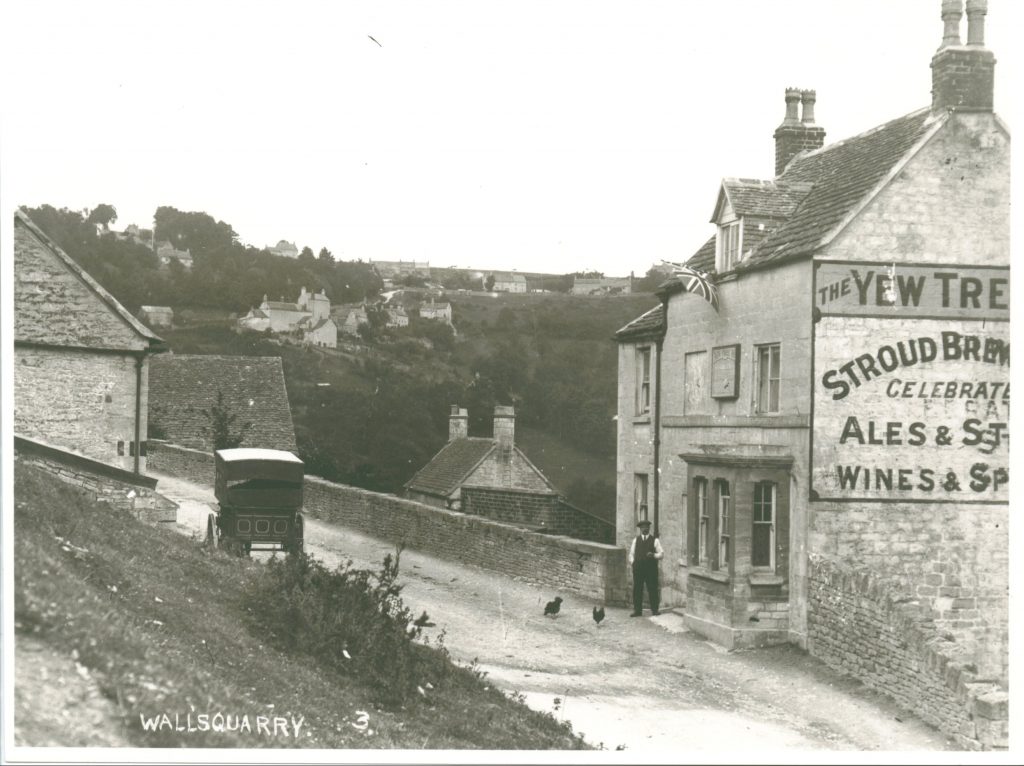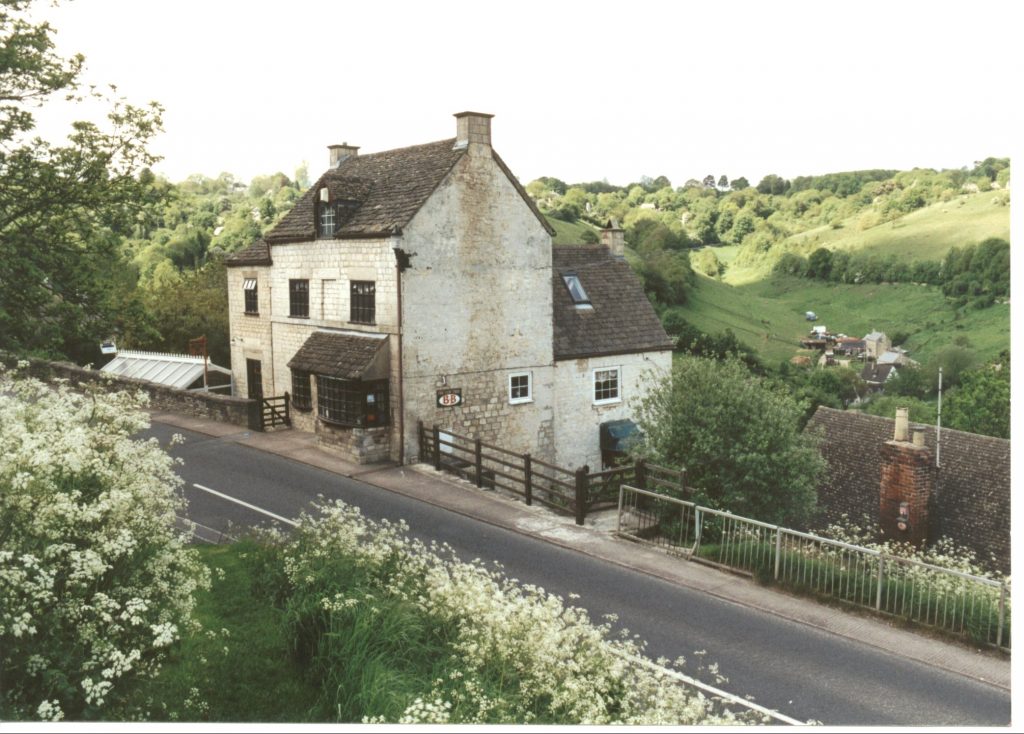ST. MARY’S CROSSING
The northern boundary of the parish of Minchinhampton is the main railway line, and between St. Mary’s Mill and the main A419 road is a manned level crossing, which has an interesting history, reflecting that of rail services in the Golden Valley as a whole.
When the main Great Western Railway route from London to Bristol was authorised in 1835, a group of businessmen in Gloucestershire saw the financial opportunities, and proposed the formation of the Cheltenham and Great Western Union Railway, with a line through Stroud, Chalford and Sapperton. The surveyor was none other than I.K. Brunel and the first section, from Swindon to Cirencester via Kemble, was opened in 1841, although landslips during the first few months of operation necessitated the rebuilding of the permanent way. The estimated cost of completion was over £700,000 exclusive of land purchase, but the G.W.R. took over the works, and pushed ahead, as a rival standard gauge line had already linked Gloucester to Birmingham. In common with G.W.R. practice, the line through the Golden Valley was broad gauge (6ft.), and it opened in May 1845, with stations at Brimscombe and Stroud serving this area. It was only in 1897, twenty years after the adoption of standard gauge and with improved locomotive design, that a station was opened at Chalford, as previously no engines had been able to make the steep climb up Sapperton Bank from a standing start by Cowcombe Hill.
Many level crossings were in existence from the first opening of the line. St. Mary’s had for a long time been an important cloth mill, employing workers from the surrounding villages, and those from Chalford needed to cross the railway line. An old right-of-way ran to the drying grounds on Rack Hill, passing over the Thames and Severn Canal close to the level crossing, and continuing up to Minchinhampton on the south side. Similar crossings existed at Ham Mill and Iles Lane.
In the early years of C20th plans had been put forward for the development of tramways in the Stroud valleys, but rather than face competition the G.W.R. set out to build a series of halts, served by a steam railmotor, especially designed for the line. The Stroud Journal reported the opening on 12th October 1903, mentioning, “the vestibule, which is at the end of the cars, is provided with steps, by means of which passengers can alight at level crossings.” In this way the railway was able to provide a cheap (Chalford to St. Mary’s 1d.), frequent (every hour) service for the workers of the area, which rivalled the omnibus. After a few months, St. Mary’s, like the halts at Brimscombe Bridge, Ham Mill and Bowbridge were provided with platforms, waiting rooms with an ornate pagoda style roof, and ticket offices – that at St. Mary’s was squeezed into the space below the signal box steps and a footbridge was built after a young lady was killed on her way to the mill.
From its opening the railmotors became extremely popular, eventually evolving into auto trains, with a saddle-tank engine pushing or pulling the train on its way between Chalford and Gloucester. Between the wars workers, shoppers and travellers seeking connections to further destinations regularly filled the coaches to overcrowding, and continued to do so until Dr. Beeching “swung his axe” onto the service in 1964. The halts were removed, along with the intermediate stations, and little remains of what might have provided a useful commuter link in the C21st.
********************
STUART HOUSE
Diana Wall
Just to the east of Butt Street lies Stuart House; its previous name was the Old Rectory. At the end of the C16th “the rectory house comprised hall, parlour, buttery, pantry, chambers, kitchen and outbuildings” and stood either in the Market Square or, more likely, at Parsons Court. However, a petition of 1720 from Edward Sheppard, Lord of the Manor, describes that house as being “very old ruinous and decayed and situate in a Low and unhealthy place”. Edward had appointed his second son Philip to the Living of Minchinhampton, and presumably wished for a better dwelling as befitting his status; Philip was Rector until his death, a total of 49 years.
The reply states “The new one as proposed to be Built is to stand in a very dry and convenient place upon the aforenamed piece or parcell of Glebe Land called the Lyes. ‘Tis to be four square with two Fronts the extent of it is to be fifty Feet on every side or thereabouts, ‘tis to be three storeys high and there are to be four rooms in every storey and by the Assistance of the aforementioned workmen we have Computed the Expense of Building … and Judge it will be Four Hundred pounds…The outhouses proposed to be built a Brewhouse about fourteen feet square and a stable three bays in Length and of a proportionable Breadth.” The new rectory was built to this design about a year later, and those who remembered it before Victorian times commented upon its well-proportioned facades with narrow sash windows. There were two entrances to the property, that from Butt Street and another to the east, and it was one of the larger dwellings in the town, comparing favourably with the Sheppard Manor House and the Lammas. All of the land to the north of Friday Street was glebe, or church-owned, land until the C19th.
The Rev. Oldfield, who was appointed in 1865, altered the Rectory considerably. He was very much a family man, which possibly accounts for the remodelling of what was then a house over a century old. The distinctive porch was added to the west front, this becoming the main entrance in preference to the lime avenue to the east, of which a few traces remain. Formal gardens were laid out and there was also a glasshouse. The centrepiece was a stone urn, and contemporary maps show a circular pool. The Oldfield family enjoyed the house for twenty years and then the Rev. Mather was incumbent until 1896. He employed five indoor servants, and an assistant gardener lived in a cottage in the grounds. It is likely that the head gardener was living in Butt Street, where a bothy still exists, or in Friday Street. However, “the house was sold c. 1915 and the Coigne, a C19th century house on the corner of Butt Street and Friday Street was acquired.”
Stuart House was divided for several occupants, and during World War II there was a move to requisition the property for use by the R.A.F. When Miss Enid Stuart, at that time living in southeast London, first thought of buying the property, she was worried that, as a disabled lady, she could find herself hostess to military officers. These fears were groundless, and she purchased the house and surrounding land in 1944. Although disabled by polio as a child and confined to a wheelchair, she took a great interest in Minchinhampton life and allowed her grounds to be used for fetes. Upon her death, she bequeathed The Old Rectory to the Gloucestershire Association for the Disabled, who renamed it Stuart House. Both the main buildings, and others in the grounds, were made fully wheelchair accessible, and the gardens to the south remodelled for disabled gardeners. A large assembly hall and kitchen facilities were built, enabling activities such as wheelchair dancing to be taught. A funding crisis within the G.A.D. led to a reappraisal of its role, and it was eventually sold to English Courtyard, which is now (2006) bringing this part of town back into the forefront of community life, with the development of Stuart Court.
********************
STUART PLAYING FIELD
A quiet haven lying between the Youth Centre and the Glebe Estate – that is the Stuart Playing Field, except of course when a sporting event is taking place! The field is one of the great assets to the community, and is home to the Minchinhampton Sports Association, and its member clubs – Minchinhampton Football Club, Minchinhampton Cricket Club (our own M.C.C.!) and Minchinhampton Tennis Club. What are the origins of this facility?
The land had originally belonged to the Rectory, now Stuart House, and when that was built in 1721 the main entrance was from near Tobacconist Farm, approaching the property from the east. In dry summers the line of the carriage drive can still be seen in the cricket outfield, and a few trees of the avenue of broad-leaved trees remain. The Rectory was altered considerably in Victorian times and a distinctive porch was added to the west front, which became the main entrance on to Butt Street, in preference to eastern route, where formal gardens were laid out close to the house. Beyond these, the land reverted to farmland. After several changes in ownership Miss Enid Stuart purchased the house and surrounding land in 1944. Although disabled by polio as a child and confined to a wheelchair, she took a great interest in Minchinhampton life and allowed her gardens to be used for fetes. Whilst maintaining a grazing tenancy, she also permitted the playing of football on her fields.
Both cricket and football in Minchinhampton have long pedigrees, although there were several periods when no formal clubs existed. A poster from 1868 advertises a cricket match near the windmill. The Common was undoubtedly the scene of many local sporting events, and even when our M.C.C. was properly established, games would take place on the Camp Field, on the edge of the Great Park. They were low scoring affairs, and this can be attributed to the playing conditions with a mown strip that would not have been rolled, so “bouncers” would catch many experienced batsmen unawares.
Football had also found a home on Camp Field, but matches were also played on the Common near “Christowe”, on the field at the top of Tetbury Street and then on Rectory Field. Changing facilities were usually in the Baptist Institute, but local pubs were also used. During the inter-war years both Box and Amberley had their own cricket and football teams. By the 1960s Minchinhampton Football Club had progressed into Division I of the Stroud League, with a team consisting mainly of players who had played locally as juniors (some of whom still live in Minchinhampton today). They were able to purchase the old NAFFI hut from Aston Down, and erected it on a concrete base at Rectory Field; at the time it was considered a first class facility with changing rooms, bath, showers and a tearoom. The Cricket Club was looking for a new ground, as their current facilities in Dr. Brown’s Road had been sold for development. Minchinhampton Tennis Club had been set up, but was hiring courts for matches at Stratford Park.
Miss Stuart was anxious to see Rectory Field become established as a sports field, so as to keep the developers at bay. In 1966 it was transferred to the Parish Council, to be run by the Stuart Playing Field Management Committee. Six years later this became the Minchinhampton Sports Association, which was registered with the Charity Commission, the field was transferred to the new body and the Bowmen of Minchinhampton, who practised along the line of the Bulwarks, joined the three existing clubs. The earthwork is a scheduled monument (although probably not connected with those on the Common as the ditch is on the opposite side) and this venue was not really ideal for archery and they later moved to a less cramped location.
The tennis, football and cricket clubs have developed and extended the amenities on the field over the last thirty years. Minchinhampton Tennis Club’s three courts are now floodlit, the football facilities have developed from that old hut, and the cricket pitch has been enhanced with the practise nets and the pavilion provided in 1997 with help from “Sport for All” – known to many Minchinhampton residents as their local Polling Station. The Stuart Playing Field is safeguarded through the Local Plan for recreational use, and although maintenance and insurance are ongoing costs for the M.S.A. their dedicated team of volunteers are ensuring that it is a landmark and prime asset for future generations.
********************
THE TRAP HOUSE
February 2004 saw the culmination of a long-standing Parish Council project – the ownership of a town centre property which could provide in a single building many of the local authority services needed by the electorate. The building purchased was “The Trap House” in West End – the name reflecting the original purpose of the building, to house a small coach or trap. However, during the course of its life it has performed many functions, although externally it is little altered from the small building erected c.1820.
The 1830 survey of Minchinhampton lists this part of the town as “House, (with a rateable value of 17s. 6d), yard and buildings”, (a further 17s. 6d.), and a garden, in the ownership of a Mr. Chalk who owned several houses in the town, but occupied by a Samuel Tainty and someone named Parsons. It was quite common at this time to sub-let properties, and it is most likely that Mr. Parsons was some kind of tradesman, who required the use of the yard. If you stand with your back to the Trap House, looking west you can pick out the roofline of one of the demolished buildings that stood on the opposite side of the open space.
The walls flanking the large entrance gates were much higher than now, and the majority of research at present leads to the suspicion that the Trap House and yard were associated with “Greylands” in the High Street. As the property was not residential there are no clues to its history in the Census records, but it is known that for a time the firm of James Simmonds (on the opposite side of West End) occupied the yard and used the Trap House as a Chapel of Rest. In 1938 the whole of the property was conveyed by a George Alfred Benjamin to “The Worlds Stores Limited” of London, and comprised two properties on the High Street, a walled garden, which some older residents may remember, the yard with stone outbuilding (Trap House), and steps down to the cellar where the reception/office area now stands. By 1965 the property had passed to “Keymarkets” and some people may remember the frontage being featured in the John Mills film “Dulcima”, based on an H.E. Bates novel.
Recent owners include Mr. Trevor Picken, who instigated most of the conversion work seen today, and used the property as a music room. Several years later Mr. Nick Atkins moved his hairdressing salon from the High Street to the Trap House, now a Listed Building, where it remained until the purchase by the Parish Council – to utilise and maintain for the generations to come.
********************
TOM LONGS POST
Tom Longs Post vies with the Market House for the most photographed part of the parish, and, of course, is so instantly recognisable that the title was taken for the title of the Parish Council newsletter.
The current post is merely the latest in a succession of direction signs, and the roads themselves have been changed to improve the safety and flow of traffic at this junction of six routes. During the Middle Ages roads were simply tracks allowing passage from one place to another, but the Manor of Minchinhampton ensured that the “beaten track” did not pass through the Great Park, the custom wood or the arable fields. Other tracks followed the spring-line below the level of the plateau, and steeper routes passed “up and over” from one valley to the next. The lines of the six roads that meet at the junction date from the turnpike era – in 1752 the road from the Bear to Blue Boys Corner was constructed, in 1785 the Thames and Severn Canal Company built Brimscombe Hill, Culver Hill was finished in 1815 after lengthy negotiations, and finally in the second half of the C19th the road was built from the Nailsworth turnpike at the Halfway House to Tom Long’s Post.
So where does the name come from? Generations of schoolchildren would like to think that it commemorates a highwayman, who held up travellers on this junction, escaping swiftly in the darkness of the Common. The idea of a highwayman extracting money has been put to good use at many charity events – notably the Country Fayres of recent years. However, records indicate that footpads and other robbers were more active to the east of the Common, on the Downs. “About half an hour after seven … two lusty footpads, armed with Horse-Pistols, attacked Mr. William Capel, in a Chaise, about the Seven-Mile Stone from Cirencester to Minchin-Hampton …” This report from 1777 is one of several in the Gloucester Journal of that period, and the earliest crime recorded for an area east of Minchinhampton is in the Calendar of Court Rolls for 1371, when a gang of robbers lay in wait for merchants using the route.
The “Victoria County History” refers the reader to a lecture given by Charles Playne of Theescombe in 1874. “Arrived at the cross roads they stop, a hole is hastily dug, and the corpse – for such it is – thrown in …the poor suicide, who hung himself in a cottage near Rodborough Manor-house, has given his name to his burial place, which is likely to endure when all recollection of the source of it has faded away.” If Houndscroft was the home of this Tom Long, there would seem to be a much nearer crossroads for his burial, and the dramatic style of the lecture has embellished other aspects of Minchinhampton history. However, Charles Playne refers to the beginning of the C19th, so it could have been well remembered when he spoke in Nailsworth.
Col. Tony Yarnold, who lived on the Cirencester Road, raised a third possibility: that of the post as the setting-down and picking-up point for carriers. From the C16th to the C19th “Tom Long” was the name given to a carrier, much as “Tommy Atkins” was the nickname for a soldier or “Jack Tar” for a sailor. This is borne out by the roads, and older tracks that meet in the area, and by references in historical records elsewhere in the country. “Chapman’s Cross” in Frampton Mansell could similarly be a reference to a peddler, or chapman, from the same date.
Whichever explanation is accepted, Tom Long’s Post remains a well-loved landmark on the Common.
********************
THE TOWN WAR MEMORIAL
Mrs. Diana Wall
Standing in the centre of the Market Square is a distinctive War Memorial designed by Sidney Barnsley, the renowned “Art and Crafts” practitioner. Until 1919, there was no large open space here; it was filled with an island of buildings with narrow streets to the east and west. The Upper Island had been cleared from the lower end of Butt Street in the C19th but Lower Island remained opposite the Market House.
At the start of the Great War the recruits for Kitchener’s army assembled in front of the Crown Inn, and marched down to Stroud led by the Town Band. A local photographer was on hand to mark the occasion, as shown below:
Sadly this “war to end all wars” was not to be over in a few months as was confidently predicted in the local press. The stalemate of the trenches in Flanders and the appalling conditions on the Turkish peninsular all took their toll, and by the time the Armistice was signed in November 1918 the parish had lost a total of fifty-one men, and many others had received wounds, gassing or shell-shock from which it would be difficult to recover.
As the war drew to a close thoughts turned to a fitting memorial to the fallen. The Parish Magazine of December 1918 states “We shall be holding a meeting before long to discuss the subject of a War Memorial to record our thanksgiving to God for victory, and to commemorate those gallant men from this Parish who have fallen during the great war. It will be felt by many that there should be a Town Memorial, but I am sure that all Church people will agree with me that there MUST be a Memorial of some sort within the Parish Church …”. In the event both church and Town received impressive memorials.
The first subscription list to be set up was for the Town Memorial, and it was felt by some that the Lower Island buildings should be purchased, renovated and turned into almshouses, or a club for returning soldiers. In April 1919 Mr. T.J. Thompson, who owned the draper’s shop in part of Lower Island conveyed his property to Lt. Col. H.G. Ricardo, the Lord of the Manor, who was acting as agent for the Trustees of the Minchinhampton War Memorial. (The others were the Rector and Churchwardens, the Chairman of the Parish Council and two representatives of the Baptist Chapel.) The Reading Room, which made up the remaining part of the Island, was conveyed at the same time. The buildings of the Lower Island were very dilapidated, and a decision was taken to remove them and erect a memorial cross in their place. This would have the added benefit of improving the flow of traffic, and opening up the top of the High Street. Sidney Barnsley, one of the celebrated Sapperton Group of craftsmen, was chosen to design the memorial. He is responsible for other crosses in Gloucestershire, notably Poulton, and his brother, Ernest, was the architect of “Westfield” facing the Great Park, and other local houses.
It would not be possible to include the names of the fallen on the cross itself, so these would be placed on tablets outside the Market House. To provide room for these the Minchinhampton Fire Brigade received notice to quit in 1919 – for many years their manual engine had been housed behind ornamental iron gates in the undercroft. The engine found a new home in the barn at the back of the Crown, and the work on the memorial went ahead. The cross and tablets cost £1236.13s.3d. raised entirely by public subscription, and included a contribution from the contingent of A.F.C. airmen based at Minchinhampton Aerodrome until 1919. Holy Trinity Church members contributed a further £500 for the erection of a Rood Screen as a further memorial, the Lawrence family paid for the Calvary in the churchyard and the Johnson family of Hyde paid for the restoration of the old font. Both Amberley and Brimscombe erected their own memorials to the fallen, although there is some duplication of names as the Town Memorial was the first to be consecrated, in October 1920.
The photographer, F. Reynolds, who published a series of postcards, recorded the dedication of the memorial. The one reproduced below shows the church memorial in the background, in front of the Victorian school.
Since 1921 local people have met around the Town Memorial on Remembrance Sunday for a service honouring those who have fallen in the name of freedom. World War II saw further names added to the tablets, some from the same families as the previous conflict. In 1946 the Daily Telegraph published a photograph of the service to represent how the countryside was marking the first year of peace. It is a tradition that exists to this day, with the Market Square falling silent as a tribute to the sacrifices demanded in war.
********************
THE VESTRY ROOM
Minchinhampton Parish Council met for the first time on January 1st 1895, a new, elected body taking over from the Vestry, a group of influential citizens who had previously administered local affairs. The first M.P.C. Chairman was the Rev. Frank Mather (who was not actually an elected councillor!!) and he opened the proceedings by stating that the Vestry Buildings, where the meeting was being held, had been the property of the Vestry, who had purchased the site for £100 in 1818. The building had been erected for £300, the cost being defrayed by parishioners. (The records show that it was actually purchased on 13th October 1817, and that part of the building was already usable as the Vestry moved their meetings there from the top room at The Crown). Therefore, argued Rev. Mather, the Vestry Room and the adjoining house were parish property and belonged to the Parish Council. It was agreed that the churchwardens could use the room for church meetings, provided it was not needed for Council use, at a payment of 5/- (25p) a year, with a further 6d for fires to be lit.
The early Parish Council kept a careful watch on their property. Repairs were carried out in 1895, and in 1899 they accepted an estimate of £27/17/6d for further building work which included opening up an old fireplace. Complaints had been received about the odour from the privy at the cottage, and it was connected, with the two adjoining properties, to the main sewer. When a new sexton was appointed in 1895 the rent paid by Holy Trinity Church for the cottage was £3 per annum.
The first Clerk to the Parish Council was W.A. Jones and he was instructed to make an inventory of the furniture in the Vestry Room, which is minuted as consisting of one desk, one oak table, the parish map and three benefit tables. These latter small tables were used in the collection of money; in 1901 the Overseer was allowed to use the room “being parish property” for collecting rates. In 1896 an order was placed for 18 armchairs “the same as those in the Board room at Stroud” and a table with linoleum for the floor. The chairs and the table (with two extra drawers inserted in 1901) are in use today. In March 1895 the Clerk reported that he had “two cartloads of parish paper” and needed something so that he could put his hand on any paper directly. The Council therefore ordered a pitch pine cupboard, to be made by Mr. W.A. Harman for £3/10/0d with a deal back and brass fittings. This too is still in the Vestry Room.
Lighting and heating were two other creature comforts provided in the latter years of the C19th. Gas was laid on in 1895, and enabled both storeys of the building to be lit, as well as the external stairs. Open fires were very time-consuming for the caretaker, so in 1901 it was decided to purchase two second-hand gas stoves from the school, at a total cost of £3, and to put one in the Vestry Room and one in “the outer vestry”.
A series of inscribed boards, relating the charity bequests to Minchinhampton, are mounted on two walls of the Vestry Room. These used to be hung in Holy Trinity Church, but were probably moved to their present position early in the last century, when the walls of the nave and chancel were re-plastered. Other historical boards are also displayed – the record of the early Bowstead Medal winners from the school and the Fire Brigade boards from the Market House. These do somewhat darken the room, even with modern electric light.
The current Parish Council has continued to maintain and improve this old building. It was refloored in the 1990s, electric heating installed, and Ron Chew constructed a display alcove for items. A few years ago four upper windows were reframed and the leaded lights replaced by Graham Dowding, the notable local expert. The interior has been redecorated, new curtains hung at the windows, and the whole thoroughly cleaned. Once the Parish Council Meetings were moved to the Trap House, the room was used for various training courses, and currently is the home of the recording studio for “Five Valley Sounds” – the local talking newspaper for the blind.
********************
THE MINCHINHAMPTON WINDMILL
Hugh Kearsey
In Stroud Museum there is a painting by Rev. Augustus Turner of the windmill that stood on Minchinhampton Common near Tom Longs Post. The painter did the painting in 1888 from an earlier sketch after the windmill had gone. Augustus Turner (1820 – 1902) lived at Dunkirk Manor, and is buried in Amberley Churchyard along with members of his family.
Was there perhaps an earlier Windmill, which stood on this site or at some other point in Minchinhampton? As early as 1712 the Will of John Philpott mentions “a piece of land at the Windmill” and Ann Guy, who died in 1718, mentions in her Will “land situate at the Windmill Street”
The subject of this article was probably built about 1803. Its life span as a trading mill was considerably briefer than would have been expected from such a Windmill. No records have yet come to light concerning customers or trades people who had dealings with the owners, but an 89 year old resident of Minchinhampton has said that his grandmother used to relate about people taking corn from a house in Brimscombe valley up to the Mill to be ground. But there is evidence that it was built very early after 1800, as it is marked on the 1803 map for the Survey & Valuation for Equalising the Poor Rates in Minchinhampton, and William Clissold was in possession and was described as “newly built” when offered for sale in 1812. The Gloucester Journal dated 12th December 1812 ran this advertisement: “TO BE SOLD BY AUCTION BY MR. GOODALL. On Saturday afternoon, the 19th day of December 1812 at 3 o’clock at the sign of The Horse & Groom, Northgate Street, Gloucester, unless previously disposed of by private contract – A CAPITAL FREEHOLD WINDMILL in excellent repair (built only 8 years since) and in full business, capable of grinding 700 bushels per week situate on the left side of the road leading from Minchinhampton to Stroud, containing two pair of stones, and every convenience there-unto belonging.”
It was bought and worked by John Dudbridge Gardiner Kearsey from 1812. By 1814, it was bought by his brother Samuel Kearsey. The Victoria County History noted that George Taylor was the miller in 1863, occupying it with Edmund Taylor, a maltster and corn dealer, presumably renting it from Samuel Kearsey. There was no automatic steering gear for keeping the sails to the wind, and no apparatus on the sails to regulate the wind pressure. In the former, it was a case of winding the top round by hand, and the latter of applying the brake, stopping the mill, and unfurling or taking in the sail-cloth, no light labour in bad weather.
The demise of the windmill was described several years afterwards in the “Stroud News” of 6th August 1919 by James W. Price who was the tenant at the time. “The driving power was from a large oak pillar from the top of the first floor and, with age, this was cracked in places, which made it a little “elastic”, so when the mill was going at full speed, what with the creaking of the timbers and the rattle of the machinery, the noise inside was most alarming, especially to a stranger. This state of affairs continued till one day in July 1871, and when the mill was working smoothly before a fair breeze, a loud rumbling noise was heard and a crash from outside. On running out to find the cause, I was startled to find a large portion of the stonework towards the top of the mill had fallen to the ground. I applied the brake, and the mill was stopped for the last time, for to continue was out of the question.”
It was demolished about 1872 “as the cost of repairs were too high and its removal would allow Windmill House to be let to a more desirable kind of tenant who otherwise would not like to look out on a decrepit windmill”. It is believed that the stone from it was used to build the lodge at the gate to Windmill House. All that remains today is the foundations buried under soil in the caravan field next to Windmill House and a piece of the iron track on which the head rotates.
********************
THE YEW TREE, WALLS QUARRY
Should you feel energetic enough to walk up Brimscombe Hill from the main road in the valley, you would pass several of the old inns, pubs or beer houses for which the Cotswolds were renown. First on the right comes “The Ship”, still serving the area, and with a name recalling the busy Brimscombe Port during the days of the canal. Further up on the left is the former “Nelson Inn”, with its sign writing still visible on the end wall. Like so many local houses it was tied to the Stroud Brewery, formerly in Rowcroft, and beneath the creeper advertises its “Ales and Stout”. At Walls Quarry there is the “Yew Tree”, featured in this article, and then further up the hill, on the right again, “The Bell”, still retaining its name as that of a house.
The well-known Stroud photographer Edwin Peckham photographed both of these last hostelries in the first half of the last century and they were both mentioned in Charles and Mary Hadfield’s guidebook “The Cotswolds” published in 1966. Miss Grace Halford, former parish councillor, believes the photographs were taken in the late 1920s or early 1930s, when the landlord at the “Yew Tree” was a Mr. Snelling. He and his family kept chickens on the other side of Brimscombe Hill, in what was once a pigsty. Delivery of vital commodities like bread would be by horse and cart, (here belonging to the Co-op) and the lack of trees meant that the boys who used the flat stretch of road from the “Yew Tree” to the Pike as their football pitch would have an uninterrupted view up onto the Common.
Miss Halford remembers, “The bay window was in the Ladies Room at the pub and the bar was a bit further in, but still on the right side of the front door.” “As a child I remember buying a packet of crisps from a little hatch on the left just inside the front door of the pub (and probably small bars of chocolate too!) Once my father bought ¼ cwt. of coal from Mr. Snelling for our neighbour Mrs. Sally Bassett … I remember seeing it being weighed. I think Dad may have carried it down on his back”
The earliest existing building on the site faces onto Water Lane, which in the C16th when the cottage was built was the more important road, as there were none on the valley bottom. The late A. Cyril Turk believed that this was a private alehouse, where the owner would have brewed beer to serve to the local clothiers and mill owners. The present “Yew Tree” was built in the middle of the C17th, with the stables a little later. The current owner says there are many examples of privies all over the garden area. It probably passed to the Stroud Brewery in the 1820s, but no one has any idea where the name originated. Two yew trees have now been planted.
The “Yew Tree” also had “STROUD BREWERY, CELEBRATED ALES & STOUTS, WINES & SPIRITS” stencilled on the end wall, although unlike those farther down it can no longer be seen. Small public houses like these grew out of cottages and houses, and served a very local, and loyal, clientele. “The Bell” and the “Yew Tree” served the farm workers and quarrymen, rather than the more rowdy, and transient canal and port workers catered for by “The Ship” and the “Nelson Inn”. The name “Walls Quarry” may suggest the use of the local stone, or could relate to the name of a family resident in the area; no definitive answer has been found. The trade of publican did not always bring in enough money for a family to survive, and it is common to find other occupations being undertaken. In a trade directory of 1867 the landlord, Charles Vines, is also described as a baker.
The general shop on the corner of “The Roundabouts” may have disappeared, but the “Yew Tree” continues to serve the local and wider community. Many visitors to the area have taken advantage of the “Bed and Breakfast” business, which can be seen as a direct successor to the “Yew Tree Inn” of previous days.
********************
